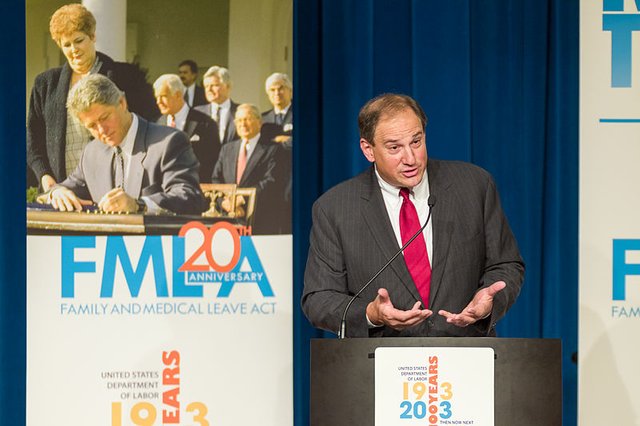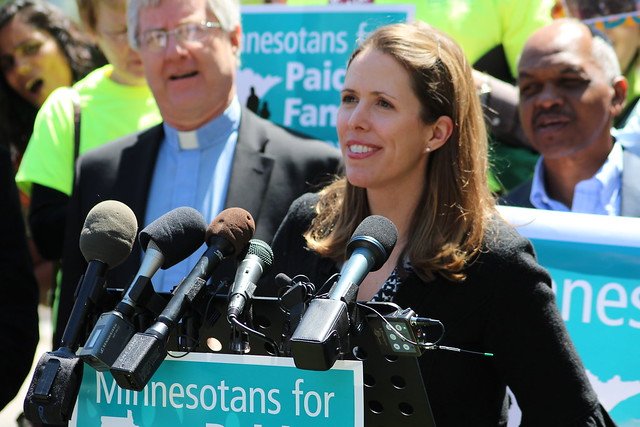
Over twenty-five years ago, on Feb. 8, 1993, President Clinton signed the Family and Medical Leave Act which mandated companies with more than 50 employees to offer 12 weeks of unpaid leave to care for a newborn, a sick family member or even their own medical problems. It was hailed as a major step in the right direction for the United States, long known as the only developed country in the world not to mandate any parental leave.
At the time, activists and advocates envisioned this measure as the bridge towards a desperately needed paid leave policy. Nevertheless, a quarter of a century has passed, and that bridge appears to have gone nowhere.
In the intervening years, many other countries have adopted paid leave policies as the United States has stood in place, content to rank last as the only industrialized nation not to offer such a policy. Indeed, the world’s wealthiest country now sits beside Papua New Guinea as the only United Nations members without paid family leave.
Excluded from the Beginning
One of the problems stems from the FMLA’s inability to cover most Americans in the first place. Due to its stipulations on company size and numbers of hours worked, it only covers about 60% of workers. Moreover, many elect not to take much unpaid leave because of the resulting financial hardship. Indeed, a quarter of women in the United States need to return to work within two weeks of giving birth in order to pay their bills.
And the statistics regarding paid leave don’t offer much encouragement. Only 14% of civilian workers have access to any type of paid leave at all.
Why is Paid Leave So Important?
In a country that appears to cherish the family unit, it seems we come up woefully short when putting those ideals into practice. What isn’t often discussed is the impact having (or not having) recovery time has on new parents.
The postpartum period following a pregnancy is when the body heals from the challenges of a pregnancy. A recent report from The New America Foundation suggests that paid leave should be a minimum of six months for the optimal health of mother and baby.
There are additional health benefits to parental leave, however, beyond recovery time for the mother. For example, infant mortality rates drop alongside increased paid maternity leave policies. Furthermore, having the time to breastfeed and bond with a newborn creates healthier kids and, therefore, less time off for workers caring for sick children.
Parental Leave for Partners the Key to Gender Equality
For generations, most Americans have accepted that a demanding career and motherhood cannot coexist peacefully. In other words, because women are usually viewed as the main caregivers, they are the ones whose careers take a backseat in the wake of motherhood.
Nevertheless, if we shift our attitudes towards fathers or non-birthing mothers as equal participants in the child-rearing process, we can change our longstanding views on gender responsibility. Essentially, the mother’s partner needs to contribute equally and to accept the parental leave available to them to achieve gender equity in the workplace.
Creating Conflict Between Employer and Employee
Unfortunately, the passage of the FMLA has, more often than not, become a sticking point between employers and employees. On the one hand, employers feel the strain of complying with the extra paperwork and the increased threat of litigation if they do not.
On the other hand, employees are rightly concerned about the coverage exclusions for small-business workers and part-time employees. In addition, lawyers who handle FMLA cases have seen numerous instances in which employees have endured retaliation for taking leave under the FMLA. Clearly, the Family and Medical Leave Act is past due for an overhaul.
States Leading the Charge
A ray of hope dawned in the twenty-first century when a few states went above and beyond government mandates to enact their own paid leave laws.
New Jersey, for example, enacted a paid family leave insurance program in 2008, succeeding California, the first state to do so six years beforehand. Rhode Island become the third state to mandate paid family leave when it introduced a similar bill in 2014. In addition, New York started paid leave at the start of this year. Interestingly, California just signed a bill last month to extend its paid leave from six to eight weeks beginning in July of 2020.
Fortunately, the new states that have taken up the mantle have improved upon the existing legislation. For instance, Rhode Island added job protection for those taking leave and New York’s 10 weeks of paid leave will extend to 12 weeks in 2021. Yet even these steps fall well short of other countries’ policies. Out of 41 nation’s studied, the lowest amount of paid leave required by the other 40 nations is approximately two months.
When Will We Join the Rest of the Developed World?
Although the U.S. has inched towards paid family leave because of a few progressive-minded states, the real question is when will congress follow suit by enacting a comprehensive, gender-neutral, federal paid leave policy that accommodates all workers, both men and women, equally.
What’s startling is that even so-called progressive outlier companies such as Netflix and the Gates Foundation only offer what at least six other nations offer to all their citizens. Consequently, we are left to wonder when the U.S. will ever catch up with the rest of the industrialized world.
While the FMLA was a clear step in the right direction, it was only the first step, and the idea was to keep moving forward in the ensuing years. Instead, we have a twenty-five-year-old policy that remains stagnant while the imperative of universal paid family leave remains in its infancy.

Congratulations @billorrin! You received a personal award!
You can view your badges on your Steem Board and compare to others on the Steem Ranking
Vote for @Steemitboard as a witness to get one more award and increased upvotes!
Downvoting a post can decrease pending rewards and make it less visible. Common reasons:
Submit